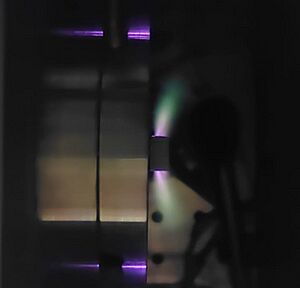Attosecond physics facts for kids

Attosecond physics, also called attophysics or attosecond science, is a part of physics. It studies how light and matter interact. This field uses incredibly short flashes of light, called attosecond pulses, to see what electrons do inside atoms, molecules, and solids. An attosecond is a tiny amount of time, 10−18 seconds, which is a billionth of a billionth of a second!
Scientists in attosecond physics often use a method called "pump-probe spectroscopy." Imagine you want to watch something happen super fast. You use one quick light pulse (the "pump") to start the action. Then, you use another quick light pulse (the "probe") to take a snapshot of what's happening. By changing the time between the pump and probe, you can create a slow-motion movie of very fast events. Because this science is complex, it needs both advanced experiments and smart computer models to understand the results.
Contents
What Attosecond Physics Studies
Attosecond physics helps us understand the super-fast movements of electrons. This knowledge can lead to new technologies.
Electrons in Atoms
Scientists look at how electrons move and interact within single atoms. They study things like:
- How electrons affect each other.
- How long it takes for an electron to leave an atom after light hits it.
- How electrons tunnel out of an atom.
Electrons in Molecules
This area explores how electrons behave in molecules and during chemical reactions. Key interests include:
- The role of electron movement when molecules are excited by light.
- How light can break molecules apart.
- How electrons move from one part of a molecule to another.
Electrons in Solids
In solid materials, attosecond physics investigates:
- How "excitons" (energy packets) move in new 2D materials.
- The super-fast motion of charge carriers (like electrons) in solids.
- How the "spin" (a tiny magnetic property) of electrons changes in magnetic materials.
Goals of Attosecond Science
A main goal of attosecond science is to get a deep understanding of how electrons move in atoms, molecules, and solids. The big challenge for the future is to be able to control these electron movements in real-time. This could lead to amazing new ways to control materials and chemical reactions.
The shortest light pulse ever created by humans is 43 attoseconds long. That's incredibly fast!
In 2022, three scientists, Anne L'Huillier, Paul Corkum, and Ferenc Krausz, won the Wolf prize in physics. They were honored for their important work in creating super-fast lasers and developing attosecond physics.
Then, in 2023, Pierre Agostini, Ferenc Krausz, and Anne L'Huillier were awarded the Nobel Prize in Physics. They received this top award for their experimental methods. These methods allow us to create attosecond light pulses and use them to study how electrons move in matter.
See also
 In Spanish: Attofísica para niños
In Spanish: Attofísica para niños
- High harmonic generation
- Femtochemistry
- Femtotechnology
- Ultrashort pulse
- Chirped pulse amplification
- Free-electron laser
- Attosecond chronoscopy

